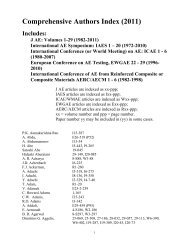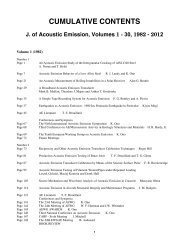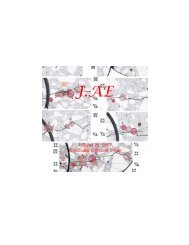Journal of AE, Volume 23, 2005 (ca. 43 MB) - AEWG
Journal of AE, Volume 23, 2005 (ca. 43 MB) - AEWG
Journal of AE, Volume 23, 2005 (ca. 43 MB) - AEWG
Create successful ePaper yourself
Turn your PDF publications into a flip-book with our unique Google optimized e-Paper software.
Then the absolute value differences <strong>of</strong> the second arrival time and each <strong>of</strong> the subsequent 48 valueswere determined. This process was continued in a similar fashion so that a total <strong>of</strong> 1225 arrivaltime differences were obtained for each <strong>ca</strong>se. These differences correspond to the e valuesin equation (6). By use <strong>of</strong> equation (6), the lo<strong>ca</strong>tion errors were determined for each <strong>of</strong> the 1225arrival time differences. Figure 9 shows as a function <strong>of</strong> the S/N ratio, the percentage <strong>of</strong> the1225 trials for each <strong>ca</strong>se when the lo<strong>ca</strong>tion error was 2 % or less based upon the sensor spacing(360 mm) for a nominal propagation distance <strong>of</strong> 180 mm in the zero-degree direction. In addition,Fig. 10 illustrates the maximum lo<strong>ca</strong>tion error found in the 1225 trials for each <strong>ca</strong>se as afunction <strong>of</strong> the S/N ratios.The data illustrated in Fig. 9 demonstrates that even with an S/N ratio <strong>of</strong> 1 to 1, at least 73 %<strong>of</strong> the 1225 lo<strong>ca</strong>tion <strong>ca</strong>lculations for each <strong>ca</strong>se resulted in a lo<strong>ca</strong>tion error that was 2 % or less.Further, Fig. 10 shows the maximum lo<strong>ca</strong>tion error for the 1225 lo<strong>ca</strong>tion <strong>ca</strong>lculations for each<strong>ca</strong>se was 13 % or less. To appreciate these results, it should be pointed out that a typi<strong>ca</strong>l fixedthreshold<strong>AE</strong> system would not even trigger on any <strong>of</strong> these signals be<strong>ca</strong>use the required lowthreshold would trigger on multiple noise spikes. Hence, the technique used here could be <strong>of</strong>value for an <strong>AE</strong> acquisition system that records continuously.At a 2 to 1 S/N ratio, Fig. 9 shows that at least 99 % <strong>of</strong> the 1225 lo<strong>ca</strong>tion <strong>ca</strong>lculations foreach <strong>ca</strong>se would have lo<strong>ca</strong>tion errors <strong>of</strong> 2 % or less. Figure 10 also shows the maximum lo<strong>ca</strong>tionerrors would be 2.4 % or less. With an S/N ratio <strong>of</strong> 2 to 1, a fixed-threshold <strong>AE</strong> system wouldlikely trigger on real <strong>AE</strong> signals instead <strong>of</strong> noise spikes. And for a source equidistant betweenthe sensors, the lo<strong>ca</strong>tion errors would not be great. The reason is that the factors <strong>of</strong> geometri<strong>ca</strong>ttenuation, dispersion, and variations in source amplitude would be the same for the signal atboth sensors. But for a fixed-threshold system, when the source is not equidistant from all thesensors, the above three factors would typi<strong>ca</strong>lly result in relatively large lo<strong>ca</strong>tion errors comparedto the 2 % lo<strong>ca</strong>tion error limit used in this research. On the other hand, the WT-based determination<strong>of</strong> arrival times would not be affected by the above three factors.11. Discussion <strong>of</strong> Lo<strong>ca</strong>tion Error Results at a 180-mm Propagation DistanceTo better appreciate just how good the above lo<strong>ca</strong>tion results are the following facts must beconsidered. The noise level was taken at the average peak value <strong>of</strong> the original set <strong>of</strong> ten noisesignals. If it had been set at the peak value (0.73 pm) <strong>of</strong> the ten signals, then the S/N ratios <strong>of</strong> 1to 1 and 2 to 1 would have been 0.86 to 1 and 1.73 to 1. Even these S/N ratios are conservativevalues from the view <strong>of</strong> a typi<strong>ca</strong>l <strong>AE</strong> experimentalist, since the peak was that for only about 16ms <strong>of</strong> noise signal data.The analysis presented in equations (1) through (6) predicts that the error in the lo<strong>ca</strong>tionshould depend linearly on the group velocity, c g . Clearly Figs. 9 and 10 do not support that conclusion.The lower group velocity <strong>of</strong> 1.8 mm/s for 522 kHz/S 0 does not give the expected betterresults. This lack <strong>of</strong> dependence on c g is likely due to the previously discussed high noise-signalenergy in the region <strong>of</strong> the 522 kHz frequency. This higher noise was evidently sufficient toovercome the expected dependence on c g .For further discussion <strong>of</strong> the lo<strong>ca</strong>tion results, it makes the most sense to focus on the fraction<strong>of</strong> the 1225 trials that resulted in lo<strong>ca</strong>tion errors <strong>of</strong> 2 % or less. The reason for this focus is thatthese results represent the average results over many trials. In contrast, the results <strong>of</strong> the16








